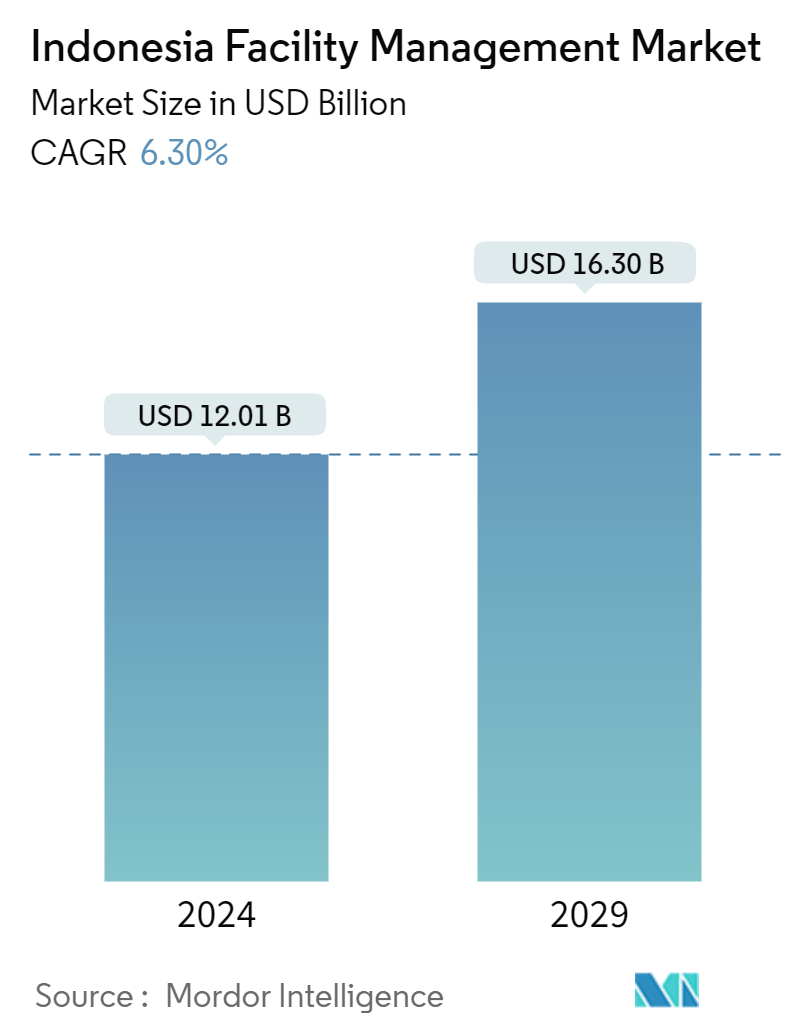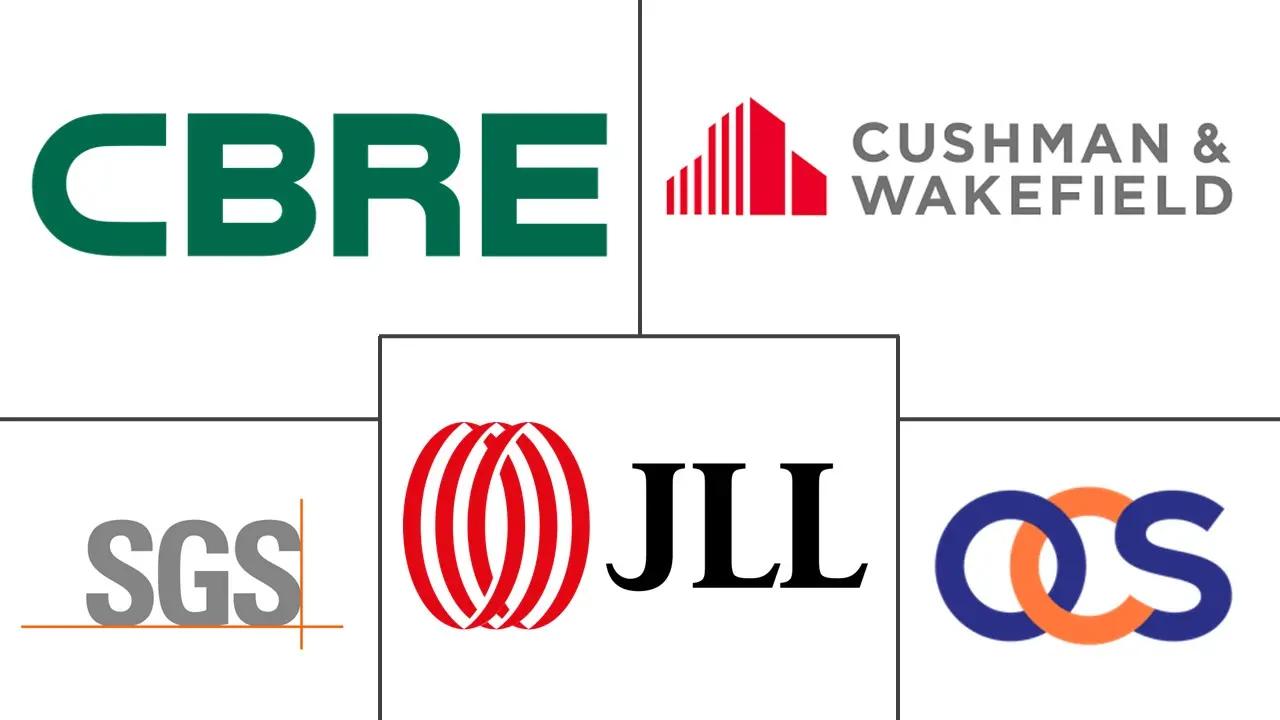Market Size of Indonesia Facility Management Industry

| Study Period | 2019 - 2029 |
| Base Year For Estimation | 2023 |
| Market Size (2024) | USD 12.01 Billion |
| Market Size (2029) | USD 16.30 Billion |
| CAGR (2024 - 2029) | 6.30 % |
| Market Concentration | Medium |
Major Players
*Disclaimer: Major Players sorted in no particular order |
Indonesia Facility Management Market Analysis
The Indonesia Facility Management Market size is estimated at USD 12.01 billion in 2024, and is expected to reach USD 16.30 billion by 2029, growing at a CAGR of 6.30% during the forecast period (2024-2029).
In Indonesia, the market is witnessing growth primarily due to the rising adoption of facility management. This trend is driven mainly by the need for resilience against disruptions, natural disasters, or unexpected events. Furthermore, there's an increasing demand for eco-friendly facility management services to reduce carbon footprints, bolstering the market's positive outlook.
- Additionally, the integration of smart building technologies and automation, which offer real-time data and control, further propels facility management's growth in Indonesia. Lastly, businesses are increasingly seeking cost-effective solutions for efficient facility management.
- The rise in the demand for commercial and industrial facilities is expected to drive the market and may create an opportunity for the market players to develop new services that cater to the demands of the clients. For instance, according to Bank Indonesia, Starting in Q1 2020, Indonesia's commercial property demand index has been on the rise, peaking at 103.85 index points in Q2 2023. This surge in demand is largely attributed to a growing number of retailers and an influx of foreign investments in the country. Further, The Commercial Property Supply Index (CPSI) for leased commercial property in the second quarter of 2023 grew 1.63% (yoy), up from 1.05% (yoy) in the first quarter of 2023.
- According to the statement by the government of Indonesia in 2023, in its 2024 budget, Indonesia is allocating IDR 40.6 trillion (USD 0.027 billion) for the construction of its new capital city. The presidential office and a dozen apartment blocks for workers are slated for completion in 2024. 2019 Southeast Asia announced plans to construct a new capital, Nusantara, on Borneo Island to replace the overcrowded and sinking Jakarta. By its projected completion in 2045, the new city is expected to amass a total cost of USD 32 billion. To date, the government has already invested IDR 32 trillion (USD 0.021 billion) in foundational infrastructure, which includes a dam and a toll road.
- Awareness of the country's demand for facilities management remains low. The local business environment poses a significant challenge, hindering a transition from in-house facility management to reliance on professional firms. Another challenge many players in the FM service sector highlight is the effort required to onboard new clients. This challenge stems from end users' preference for quicker ROI and a desire for lower upfront investments.
- The growth of Indonesia's GDP plays a pivotal role in the expansion of the facilities management market. As the economy grows, there's a surge in construction activities, infrastructure development, and real estate investments, all fueling the demand for FM services. Furthermore, robust economic performance motivates businesses to outsource non-core operations, such as facilities management. For instance, according to IMF, Indonesia's gross domestic product (GDP) in current prices is projected to rise by a total of USD 719.1 billion (+48.73 %) from 2024 to 2029.
Indonesia Facility Management Industry Segmentation
The study tracks the facility management (FM) industry-related trends in Indonesia by analyzing the demand for FM services in the country. Facility management confines multiple disciplines to ensure functionality, comfort, safety, and efficiency of any building by integrating people, place, process, and technology. The Indonesia facility management market is defined based on the revenues generated from the services that are being used by various end-users, such as commercial, institutional, public/infrastructure, industrial, and other end users across the country. The analysis is based on the market insights captured through secondary research and the primaries. The report also covers the major factors impacting the growth of the market in terms of drivers and restraints.
The Indonesia facility management market is segmented by type (In-house facility management and outsourced facility management [single FM, bundled FM, and integrated FM]), offerings (hard FM and soft FM), end-user industry (commercial, institutional, public/infrastructure, industrial, other end-users). The report offers market forecasts and size in value (USD) for all the above segments.
| By Type | |||||
| In-house Facility Management | |||||
|
| By Offerings | |
| Hard FM | |
| Soft FM |
| By End-user Industry | |
| Commercial | |
| Institutional | |
| Public/Infrastructure | |
| Industrial | |
| Other End-user Industries |
Indonesia Facility Management Market Size Summary
The Indonesia Facility Management Market is poised for significant growth, driven primarily by the expansion of the construction sector, which has seen consistent investment from both public and private entities. The entry of global technology companies into the Indonesian market has further fueled the demand for facility management services, particularly in the data center sector. Despite the promising growth trajectory, the penetration of facility management services in Indonesia remains lower compared to countries like China, with integrated services still in their early stages. The market experienced a temporary slowdown due to the COVID-19 pandemic, but is expected to recover and expand as vaccination efforts progress and restrictions ease.
The manufacturing sector in Indonesia has become a crucial component of the national economy, with facility management services playing a vital role in optimizing operational efficiency and reducing costs. The government's initiative, Making Indonesia 4.0, aims to enhance the manufacturing sector's growth through the adoption of Industry 4.0 technologies, creating further opportunities for facility management providers. The demand for these services is also bolstered by the increasing construction of commercial infrastructure and data centers, driven by the presence of multinational corporations and government investments in public infrastructure. The market is moderately competitive, with key players focusing on tailored solutions to meet local needs.
Indonesia Facility Management Market Size - Table of Contents
-
1. MARKET INSIGHTS
-
1.1 Market Overview
-
1.2 Industry Attractiveness - Porter's Five Forces Analysis
-
1.2.1 Threat of New Entrants
-
1.2.2 Bargaining Power of Buyers
-
1.2.3 Bargaining Power of Suppliers
-
1.2.4 Threat of Substitutes
-
1.2.5 Intensity of Competitive Rivalry
-
-
1.3 Assessment of Macroeconomic Factors on the Market
-
-
2. MARKET SEGMENTATION
-
2.1 By Type
-
2.1.1 In-house Facility Management
-
2.1.2 Outsourced Facility Management
-
2.1.2.1 Single FM
-
2.1.2.2 Bundled FM
-
2.1.2.3 Integrated FM
-
-
-
2.2 By Offerings
-
2.2.1 Hard FM
-
2.2.2 Soft FM
-
-
2.3 By End-user Industry
-
2.3.1 Commercial
-
2.3.2 Institutional
-
2.3.3 Public/Infrastructure
-
2.3.4 Industrial
-
2.3.5 Other End-user Industries
-
-
Indonesia Facility Management Market Size FAQs
How big is the Indonesia Facility Management Market?
The Indonesia Facility Management Market size is expected to reach USD 12.01 billion in 2024 and grow at a CAGR of 6.30% to reach USD 16.30 billion by 2029.
What is the current Indonesia Facility Management Market size?
In 2024, the Indonesia Facility Management Market size is expected to reach USD 12.01 billion.

